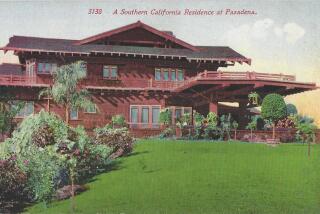A Defender of Spain’s Mix of Architecture
- Share via
A woman who signs her letter Mercedes, Countess Labajos, writes to chide me about my criticism of two famous monuments in Spain.
One is the Christian cathedral in the mosque at Cordoba. As I noted, in the 16th Century the Christian fathers built their cathedral in the heart of the great Muslim mosque, holing the ceiling for its dome. I thought it was arrogant of them, to say the least.
The other is the Renaissance palace built by the Emperor Charles V in the Alhambra. Though it is praised as a fine example of its classic style, among the Alhambra’s delicately graceful Moorish structures it looked to me like a boot planted in a bed of Johnny-jump-ups.
It is ironic to me that Charles himself deplored the cathedral in the mosque, though it was erected in God’s name, but evidently saw no incongruity in placing his own monument among the Muslim gems.
I must admit, though, that Countess Labajos makes some good points. “Sometimes architectural purity is much less important than historical signification,” she says, “and what you saw in Cordoba is a meaningful and abridged statement of Spanish history.
“Think of my country as a truly frontier land: Europe versus Africa, West versus East, Atlantic versus Mediterranean. The cathedral is the symbol of Spain as a truly Western country; we did not want to be Muslims. And this fact had such large and embracing consequences, that, like a music rising long and wide, it has come to die here, in California, by the shores of the Pacific, with the resounding notes of all the Spanish names around. . . .”
Anyone who lives in Southern California and likes its architecture, as I do, is in no position to protest the anomalous mixture of style in Spain. As for classical being next door to Moorish, all we have to do is look in our own backyards.
Do you remember Nathanael West’s description of the Hollywood hills in “The Day of the Locust”?--”But not even the soft wash of dust could help the houses. Only dynamite would be of any use against the Mexican ranch houses, Samoan huts, Mediterranean villas, Egyptian and Japanese temples, Swiss chalets, Tudor cottages, and every possible combination of these styles that lined the slopes of the canyon.”
He didn’t mention the Moorish imitations, but they exist, even today, looking like miniature mosques or alcazars.
Countess Labajos is right, too, in pointing out the historical significance of the cathedral in the mosque and the palace in the Alhambra. It would be hard to design more graphic mementos of the Christian reconquest of Spain. Perhaps that’s why I found them so fascinating. It is aesthetically shocking to see those two enormous structures where they are, but it leaves no doubt in the viewer’s mind who finally won the war.
Commenting on my stories, Countess Labajos says: “It looks as if in spite of the disturbance of getting lost in the old cities, Iberia is just a pleasant, uneventful land, full of castles and old monuments. I keep waiting, expectantly, for some more scrutinizing remarks, some more disturbing anecdote, some sharp or rewarding criticism.”
In writing about my travels I have always been careful not to pretend to have penetrated the cliches and attained some profound insights or wisdom into the unknown lands through which I have dragged myself. Only by living in a place can we understand it. I don’t even understand Los Angeles. I doubt that anyone does, but I am always reading critical appraisals of this city by other journalists who have stayed three days at the Beverly Hills Hotel and been to Disneyland, Universal Studios and Rodeo Drive.
I concede that my accounts of Iberia were not scrutinizing. That is the price of hurry-up travel. One never sees anything but what is laid out for one and, finally, what one most looks forward to is not another castle or cathedral but a glass of wine at the end of the day, a good dinner, and a firm bed. I imagine that when the Emperor Charles V visited his palace at the Alhambra, that’s what he wanted, too.
We should be grateful, anyway, for the Spanish influence which, rising long and wide, like music, has come to the shores of the Pacific not to die, but to be reborn.
More to Read
The biggest entertainment stories
Get our big stories about Hollywood, film, television, music, arts, culture and more right in your inbox as soon as they publish.
You may occasionally receive promotional content from the Los Angeles Times.










